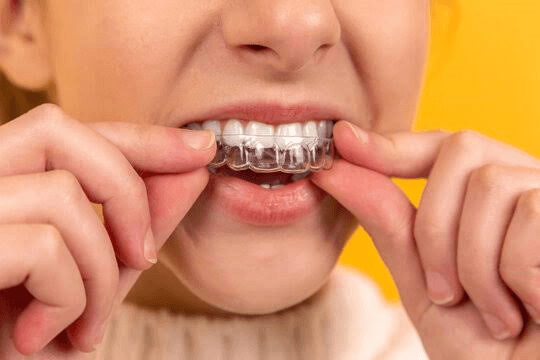What Does A TMJ Splint Look Like

Temporomandibular joint (TMJ) disorder is a condition that affects the joint connecting the jawbone to the skull, causing TMJ pain. It is a common condition that many people experience at some point in their lives. TMJ disorder can cause pain and discomfort in the jaw joint and jaw muscles, as well as limited jaw movement. It may be caused by various factors such as jaw injuries, teeth grinding, stress, or misalignment of the joint.
Symptoms of TMJ disorder can vary from person to person and may include lower jaw or upper jaw pain, clicking or popping sounds when opening or closing the mouth, headaches, and facial pain. Treatment options for TMJ disorder depend on the severity of the symptoms and can include self-care measures, medications, and in some cases, dental or surgical interventions and even the use of a dental device called a splint.
So what does a Temporomandibular joint splint look like? Read more as we’ll talk about this topic in today’s post.
What Does This Appliance look like
A TMJ splint, also known as occlusal splint, is a dental device used to alleviate the symptoms of TMJ Disorder or TMD. It functions by repositioning the jaw, relieving pressure on the jaw joint, and correcting the bite. The splint is typically custom-made from plastic and fits over the upper or lower teeth.
The TMJ appliance, also known as a dental night guard, works by providing a physical barrier between the upper and lower teeth, thus alleviating grinding or clenching habits that often cause TMJ. This further reduces jaw strain, muscle discomfort, and prevents long-term damage to the teeth and mandibular joint.
There are several different types of occlusal splints used for treating TMJ disorders during splint therapy. These include stabilization or flat plane splints, which are used to relieve the TMD pain, and anterior positioning splints, which help to reposition the jaw. Another variation is the pivot or posterior repositioning splint for backward re-positioning of the jaw. Lastly, there are distraction splints that are designed to create a gap between the teeth for joint relief. The type of splint recommended for treatment will depend on the specific issue and condition of the patient’s TMJ disorder.
An occlusal splint is typically worn for several weeks to several months, depending on the severity of the condition. It is worn primarily during sleep, but in severe cases, it may also be worn during the day. The exact duration and time of wear can vary based on a doctor’s specific recommendations.
Also, an occlusal splint is typically comfortable to wear. Once custom-made to fit your mouth perfectly, it should not cause any discomfort or restrict breathing in any way. Initial feelings of slight unfamiliarity usually disappear after a few nights of continuous usage.
An over-the-counter mouth guards can be purchased from drugstores or online retailers. These self-moldable, at-home devices are designed to alleviate TMJ disorder symptoms. However, they may not fit as precisely as custom-made devices from a dentist and prolonged use should be vetted by a healthcare professional to prevent potential complications.
Whether an insurance policy covers the cost of a dental night guard for dental appliance therapy depends on the specific plan and provider. Some insurance companies classify an occlusal splint as dental or medical necessity, thus providing coverage. However, others might not consider it essential, leaving patients responsible for the cost. Always check with your insurance provider for clarification.
How To Take Care Of A Dental Night Guard?
Taking care of an occlusal splint involves daily maintenance and proper storage. Firstly, ensure that you’re cleaning the splint daily. Remove the appliance from your mouth and brush it gently using a toothbrush and cold water. Avoid using hot water or toothpaste as they can potentially damage the material. After cleaning, place the TMJ splint in its protective case, never leave it out in the open or in direct sunlight. Regularly inspect your splint for signs of wear or damage. If you notice any changes in the fit or appearance, promptly consult your dentist or oral specialist, they can adjust it or recommend a replacement if necessary.
Conclusion
To sum up, a temporomandibular joint splint, or also referred to as a mouth guard or an oral appliance, is a beneficial tool designed to alleviate the discomforting symptoms of TMJ disorders. It is custom-made and attached to either the top or bottom set of teeth, altering the bite to reduce strain on the TMJ and preventing teeth grinding.
And by following the care tips mentioned above such as cleaning the splint daily, proper storage when not in use, regular check-ups with your dentist to monitor your progress, and maintaining healthy jaw habits can ensure its optimum functioning and longevity.
